Linear Scale Patterns: How to Break Out of the Box Forever
Learn how to escape the tight, often limiting confines of “box” scale patterns.
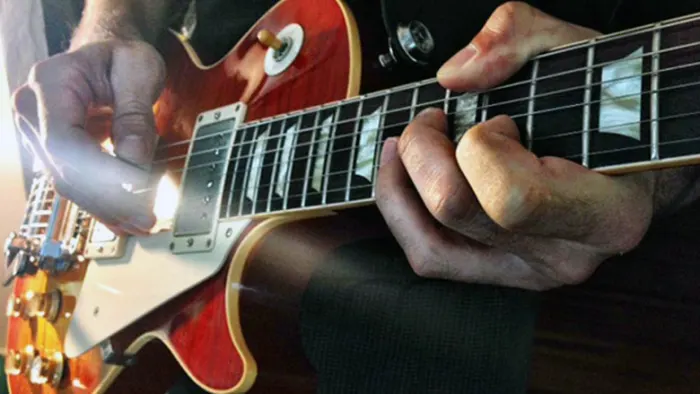
Have you ever been mystified by the way some guitarists can soar freely up and down the fretboard, seemingly unrestricted by standard “box” scale patterns?
Apart from sheer speed and a knack for linking neighboring patterns, one secret weapon of these sick axe-slingers is a system of linear patterns. Since such patterns traverse the neck horizontally (up and down the fretboard) rather than vertically (across the fretboard), they might be just the keys you’ve been searching for to help you escape the tight, often limiting confines of boxes.
LINEAR SCALE PATTERNS
One common system for creating linear patterns involves grouping the notes of a scale in a series of symmetrical two string-set shapes and repeating them up the fretboard. FIGURE 1A applies this concept to the G minor pentatonic scale (G-Bb-C-D-F). All of the scale’s pitches are represented in a five-note symmetrical pattern established on the lowest string pair: the F and G notes (b7th and root) lie on string 6; Bb, C, and D (b3rd, 4th and 5th) on string 5. The same pattern is repeated on strings 4–3-two frets up from the starting point, or an octave up, and then again another octave up, on strings 2–1. This two-string-set system not only promotes fretboard memorization but also facilitates picking, legato patterns, and consistent fret-hand fingering—all of which will in turn increase speed as well as accuracy. Check out FIGURE 1B, in which each slide puts you into position for a smooth transition to the next string set.
FIGURES 1A–B
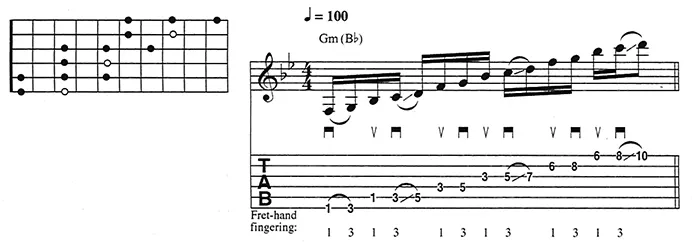
FIGURE 2A applies the two string-set principle to the F major pentatonic scale (F-G-A-C-D). Again, the symmetrical nature of the pattern allows for consistent fingering and picking deployment, as shown in FIGURE 2B. Also, you can get extra mileage from these two patterns by using them for relative pentatonic phrases. (The G minor pentatonic scale is relative to the Bb major pentatonic scale, the F major pentatonic scale is relative to the D minor pentatonic scale, and so forth.)
FIGURES 2A–B
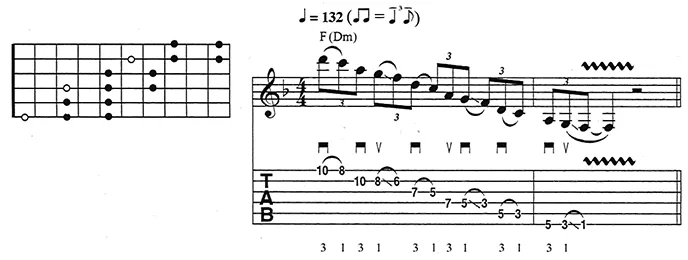
The two-string-set system works beautifully for pentatonic scales, but it can be applied to virtually any scale. Granted, the more notes in the scale, the more involved the adjacent-string patterns will be. But with personalized fret-hand fingerings and shifting strategies, you’ll find the system to be highly useful for sailing up and down the neck and for conveniently getting from point A to point B. FIGURES 3A–H offer a number of linear patterns for a variety of scales. Play through them slowly and carefully, working out your own legato moves (slides, hammer-ons and pull-offs) as you go.
FIGURES 3A–H
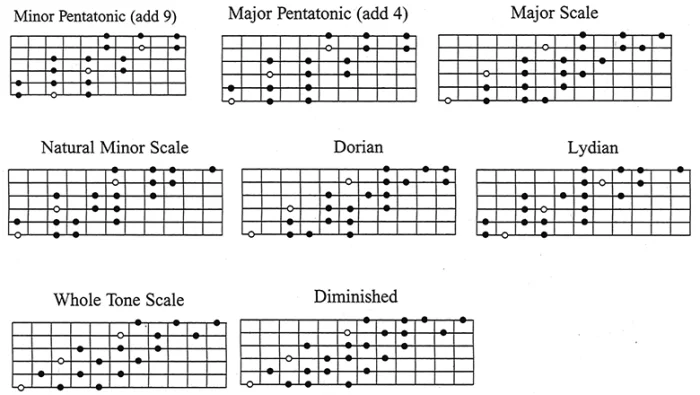
OTHER LINEAR CONCEPTS
A simple but often overlooked linear tactic is to play an entire scale on a single string. FIGURE 4 depicts the E Mixolydian mode (E-F#-G#-A-B-C#-D) dispatched legato-style along string 3.
FIGURE 4
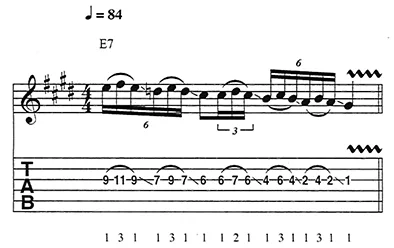
FIGURE 5 presents a linear stratagem based on neighboring pentatonic patterns. Played exclusively along strings 1–2, the phrase traverses the top portions of the five box patterns of the A minor pentatonic scale (A-C-D-E-G).
FIGURE 5

Arpeggios also make great candidates in a linear campaign. FIGURES 6A–D show some useful patterns fashioned from the two-string-set concept. Don’t be fooled by the fact that three of them start on the given scale’s 5th degree—lining up the notes in this order affords clear symmetrical contours and results in a pattern that is extremely well suited for legato moves, as you will see and hear in the solo.
FIGURES 6A–D


THE SOLO
Now let’s put some of these linear patterns and concepts to use [FIGURE 7]. In this solo, we’ll rock out over a 17-measure progression in the key of G minor. Notice that this solo is divided into two parts: the first section (measures 1–8) rides a i-bVII-bVI-biii-V7 progression (Gm-F-Eb-Bb-D7). The second section (measures 9–17) opens on the bVI chord (Eb), and then returns to the i chord for an ascending chordal cadence (i-bIII-iv-bVI (Gm-Bb-Cm-Eb) before wrapping up with a V-i (D7–Gm) change.
After a couple of 16th-note scratches in the pickup measure, the solo opens with a snarling 6th-string G and a two-bar ascending run in G minor pentatonic (G-Bb-C-D-F). Carved from the pattern in FIGURE 1A, the passage leads to the target note, C (the 5th degree of the F chord), at the top of measure 3. From there, the melody cascades down a syncopated sequenced version of the major-pentatonic pattern in FIGURE 2A.
Measure 5 brings the Eb chord, for which we’ll deploy a palm-muted Cm7 arpeggio in linear fashion (see FIGURE 6B). The muting is released at the top of measure 6, where the ascending phrase segues to a descending Ebmaj7 arpeggio, courtesy of FIGURE 6A’s pattern. Use your 1st and 4th fingers to fret these widespread notes. Measure 7 contains the Bb change, as well as another sequenced phrase, this time riding the Bb major pentatonic scale (Bb-C-D-F-G) and shaped from the linear pattern in FIGURE 2A. The V7 chord (D7) marks the end of the first section, whereupon an emotive, Dadd4 arpeggio (D-F#-G-A) tumbles down the fretboard in linear fashion. This move is perhaps best explained as a four-note pattern (G-F#-D-A) played on strings 1–3 and repeated an octave below on strings 3–5.
Look back over the previous measures and you’ll see a triplet-fueled pathway sprinkled with a few rests (for breathing) and ties (for syncopation). The second section, on the other hand, marks a rhythmic turning point: a stream of quarter-note triplets interspersed with swung eighth notes. In the opening measures of this section (9–10), selected notes from Eb Lydian (Eb-F-G-A-Bb-C-D) provide the melodic fuel, informing a phrase borne of the Lydian pattern in FIGURE 3E. Next, measures 11–12 revisit the rhythmic theme from the first section, as a speedy Gm7 arpeggio run spills into a slippery Bb major pentatonic passage that climbs back up the fretboard in a three-notes-per-string fashion.
Measures 13–15 marry the rhythmic themes from both sections in a tantalizing melodic recipe consisting of a Cm triad (C-Eb-G), the C Dorian mode (C-D-Eb F-G-A-Bb), and the Eb major pentatonic (Eb-F-G-Bb-C) scale. The Cm triad maneuver finds its origins in the neighboring-patterns concept explained in FIGURE 5. Whereas that example skipped along the top of pentatonic boxes, this lick skirts the 3rd- and 2nd-string portions of standard Cm triad patterns. Selected members of C Dorian supply the notes for the subsequent open-string passage, and Eb major pentatonics are spread out along the inner four-string set.
For the grand finale (measures 16–17), a pair of sequenced arpeggios (D7 and F#07) zip down the neck, and the solo goes out on a heavily vibratoed G and subsequent gliss.
FIGURE 7
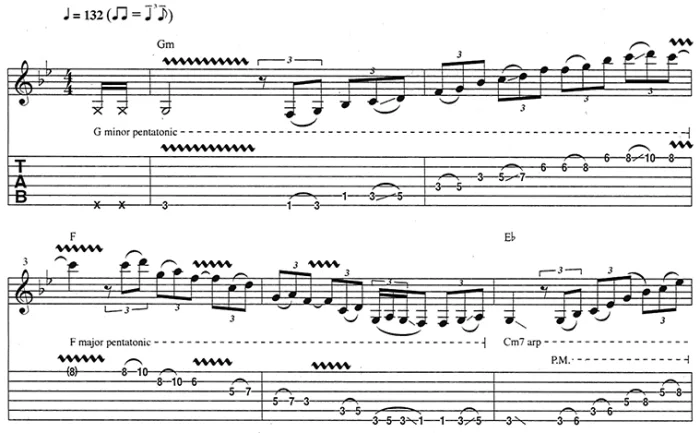
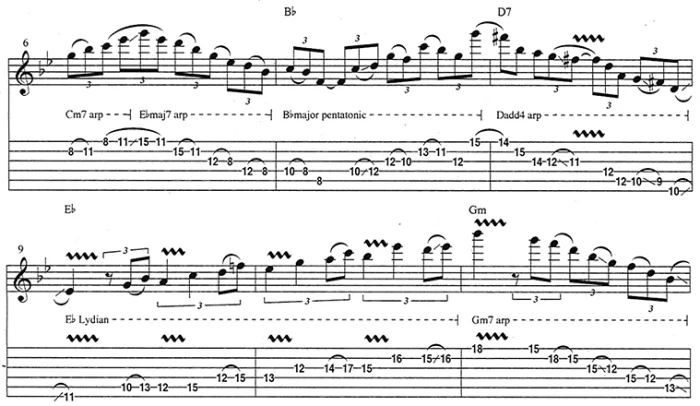
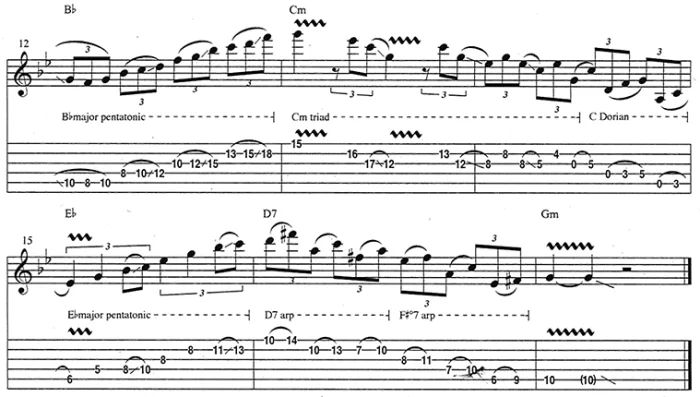
Get The Pick Newsletter
All the latest guitar news, interviews, lessons, reviews, deals and more, direct to your inbox!
Guitar Player is the world’s most comprehensive, trusted and insightful guitar publication for passionate guitarists and active musicians of all ages. Guitar Player magazine is published 13 times a year in print and digital formats. The magazine was established in 1967 and is the world's oldest guitar magazine. When "Guitar Player Staff" is credited as the author, it's usually because more than one author on the team has created the story.
“Write for five minutes a day. I mean, who can’t manage that?” Mike Stern's top five guitar tips include one simple fix to help you develop your personal guitar style
"It’s like you’re making a statement. And you never know where it’ll lead." Pete Thorn shares the tip that convinced Joe Satriani he was the right guitarist for the SatchVai Band










